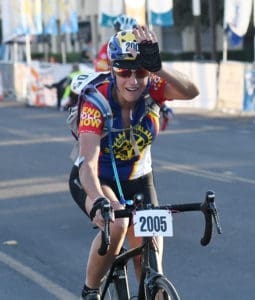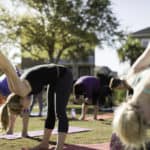 In November 2015, I was on a flight bound for Tucson, Az., to participate in the 100-mile El Tour de Tucson cycling event as a member of Rotary International’s Miles to End Polio team. El Tour de Tucson is a 40-year-old cycling event with more than 9,000 entrants. I was in my mid-50s, and the majority of my thoughts involved questioning my sanity.
In November 2015, I was on a flight bound for Tucson, Az., to participate in the 100-mile El Tour de Tucson cycling event as a member of Rotary International’s Miles to End Polio team. El Tour de Tucson is a 40-year-old cycling event with more than 9,000 entrants. I was in my mid-50s, and the majority of my thoughts involved questioning my sanity.
This was my perspective on this day…I had never ridden a road bike until less than two months prior to boarding this flight. I had not used clipless pedals until a month prior and had the road rash and bruises to prove it. Yet here I was enroute to ride a 100-mile course that was basically the perimeter of the city of Tucson.
Why was I doing this?
Two reasons: I had raised a substantial amount of contributions in support of my organization, and a large group of people were counting on me to complete this ride. There was no backing out. But just as important, a women cyclist told me there was no reason I could not do this.
Despite being athletic and an avid spin-class attendee, in reality, there were many reasons to believe I could not do this; I had never ridden an open course with a group of people, I was not knowledgeable about how a road bike worked…and I was clipped in to those pedals. Yet, early on a Saturday morning, I was at the starting line along with 9,000 other cyclists of every shape, size, age and ability. The gun went off, and so did we.
I had five teammates – three of whom were women younger than me. They were not the svelte women you see in cycling magazines, but they knew how to ride. I did not, and for the majority of the next eight hours I rode alone through the gorgeous desert of Tucson, through the traffic of downtown Tucson, up and down hills. I rode alone at a painfully slow pace. But I did not crash, and after nearly nine hours in the saddle, I crossed the finish line. And I was not the last to do so.
During the brief time I was training, I rode with a guy. His way of encouraging me consisted of telling me there was no way I could ever ride 100 miles. Yet I was there, and he was not. The first thing I did when they put the commemorative medal around my neck was text a photo to him. There was no need to add commentary.
I learned a great deal during the eight-plus hours I was in the saddle. I learned to silence the voice of doubt in my head. I learned to keep pedaling, no matter what the pace. I learned that people are far less judgmental of us than we are of ourselves. I learned that there is great power in people telling you it is possible to do something you don’t believe you are capable of. I learned to listen to those people and not the ones who, for whatever reason, feel they need to negate your dream.
Later that evening, after my teammates and I were showered, fed and giddy over what we had accomplished, I committed to repeating the ride in 2016. And I did. I was a better rider this time and had at least one companion the entire ride. Most importantly, I was able to encourage those women who were me a year prior: uncertain, questioning their sanity, doubting their ability. Over and over, I said to complete strangers, “There is no reason you cannot do this.”
If you are a woman who believes you can never get on a bike and ride even 10 miles, I urge you to ignore that voice of doubt, find a cycle group or one positive rider with some experience, rent or borrow a bike, swing your leg over that bar and ride. You are stronger and more capable than you believe you are.

